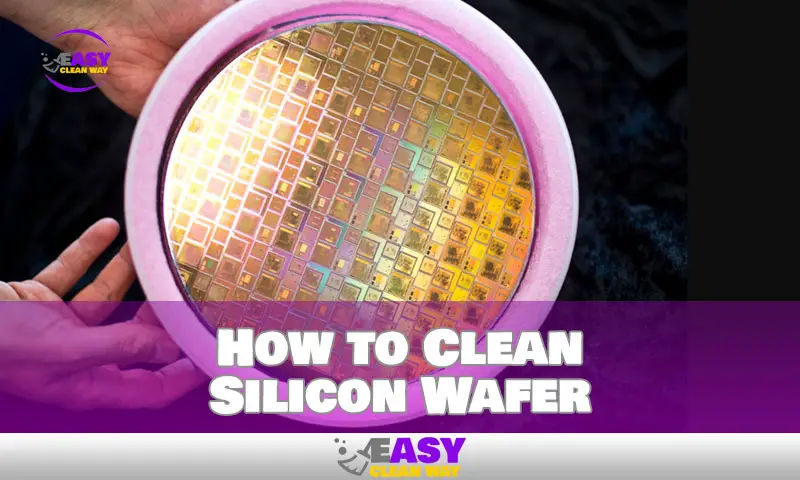Cleaning a silicon wafer requires a precise process to ensure it meets industry standards. Whether you’re a student or a professional, getting a handle on the process for cleaning a silicon wafer is essential for success.
Cleaning a silicon wafer is not difficult, but it does require close attention to detail and a specific approach. To make sure that your wafer is clean, here’s an in-depth guide on the step-by-step process of how to clean your silicon wafer properly.
In this guide, we’ll walk you through each and every step, from selecting the right materials to using the proper techniques for cleaning your silicon wafer. We’ll also provide helpful tips and advice to ensure that your silicon wafer is left sparkling and ready for use. Read on to start preparing your materials and get started cleaning.
What Is a Silicon Wafer?
Silicon wafers are thin slices of semiconductor material that have been cut from a single crystal silicon ingot. These wafers are used as the basis for semiconductor devices, such as transistors and diodes, which are important components of integrated circuits and computer chips. As such, silicon wafers also serve as the backbone for consumer products like cell phones, computers, and tablets.
It’s essential to keep these wafers clean during production to ensure that the devices produced from them remain defect-free. Proper cleaning techniques for silicon wafers such as degreasing and chemical cleaning must be followed in order to prevent contaminants from affecting their performance. In this guide, we will go through the steps on how to clean silicon wafer to ensure their quality during the manufacturing process.
Safety Precautions to Take Before Cleaning a Silicon Wafer
Cleaning a silicon wafer can be dangerous if not done properly, so it’s important to take the necessary safety precautions before starting. Here are some steps you should take to ensure that your cleaning process is successful and safe:
- Wear protective gear such as goggles, gloves, and a lab coat at all times.
- Make sure the area is well ventilated.
- Keep flammable materials away from the work area.
- Read and follow all safety instructions listed in the chemical’s MSDS (Material Safety Data Sheet).
- Keep any containers of chemicals tightly closed when not in use.
- Dispose of any chemicals correctly according to local regulations.
By following these steps, you can ensure that your cleaning process is both safe and effective.
Step-by-Step Guide on How to Clean Silicon Wafer
Now it’s time to actually clean your silicon wafer. Cleaning silicon wafer is a delicate process, as you can damage the wafer very easily.
Here’s a step-by-step guide to help you get it right:
Step 1: Inspect for Defects
Using the microscope, inspect each wafer for any visible defects that could affect its overall performance. If you find any scratches or chips, mark them with permanent markers or crayons for identification and set them aside for later.
Step 2: Deionized Water Rinse
Submerge the silicon wafer in deionized water and apply gentle pressure using soft brushes to remove all dirt and dust from the surface. To prevent streaking, avoid prolonged exposure to air while brushing the surface. Be sure to rinse it until the water runs clear.
Step 3: Ultrasonic Rinse
After rinsing with deionized water, transfer the silicon wafers into a suitable ultrasonic bath so that they can be exposed to high frequency sound waves that are powerful enough to dislodge any remaining contaminants on the surface of the silicon wafers. Leave them in there until all particles are removed and then rinse thoroughly with deionized water again.
Step 4: Etching/Cleaning Solution Bath
Next, immerse your silicon wafer in an etching and cleaning solution bath, such as hydrofluoric acid or potassium hydroxide. This will help remove any organic material from the surface of your silicon wafers and make sure that they are squeaky clean. Follow the instructions on your cleaning material’s label.
Common Solutions Used to Clean a Silicon Wafer
Want to know how to clean a silicon wafer? It’s not as hard as you might think. Cleaning a silicon wafer requires the use of special solutions that are specifically designed for this purpose.
Here are some of the most common solutions used to clean a silicon wafer:
De-ionized water (DI Water)
De-ionized water is great for cleaning silicon wafers, because it doesn’t contain any impurities like ions or minerals, which can create buildup on the surface of the wafer. De-ionized water is also relatively cost-effective and environmentally friendly, making it a great choice for those looking to save money and save the environment.
Isopropyl alcohol (IPA)
Isopropyl alcohol is another popular cleaning solution used on silicon wafers, because it dissolves particles that attach to the surface of the wafer and eliminates contaminants quickly. Isopropyl alcohol does not induce stress onto the surface so it is great for delicate projects like cleaning a silicon wafer.
Detergent Solutions
Detergent solutions are typically mixed with water and used to clean surfaces before applying other liquids like IPA or DI water. Just make sure that you rinse off any detergent residue before doing any other steps in cleaning your silicon wafer — otherwise, those residue bubbles may cause damage down the line.
Choosing the Right Cleaning Solution for Your Specific Application
It is important to choose the right cleaning solution for your specific application. The type of solution you choose depends on the type of wafer you are cleaning, the contaminants to be removed, and the desired end results. If you are unsure about which cleaning solution is best for your needs, it is best to consult a specialist to ensure that you are using the best possible cleaning method for your application.
When cleaning a silicon wafer, it is also important to consider the safety precautions associated with the cleaning solutions you use. Be sure to wear protective clothing, goggles, and gloves when handling any of these cleaning solutions. Additionally, be sure to store the solutions in a cool, dry place away from any heat sources. By following these safety precautions, you can ensure that your silicon wafer cleaning process is safe and effective.
Hazards of Not Properly Cleaning Silicon Wafers
If not properly cleaned, a silicon wafer can be contaminated with unwanted particles, which can lead to a variety of problems. Contamination can cause defects in the wafer, which can lead to significant production delays. Additionally, contamination can lead to electrical problems such as shorts and crosstalk. It is also important to note that if a wafer is not properly cleaned, it can become brittle and break more easily. By properly cleaning a silicon wafer, you can be sure that your product will be of the highest quality and will meet the industry standards.
People Also Like: How to Clean Ball Pit Balls Faster and Easier
Conclusion
Silicon wafers must always be handled and cleaned with care to ensure reliable and repeatable results. Taking the time to use the right cleaning and handling protocols will help ensure that your silicon wafer is clean and free of contaminants.
By following the step-by-step guide of how to clean a silicon wafer, you can ensure that your process remains uninterrupted and all of your components remain clean and reliable. Whether you’re using a manual or automated process, the right cleaning and handling techniques will help you get the most out of your silicon wafer.
Hey there! I’m Alton Smith, your Clean Expert blogger. I’m on a quest to help you conquer chaos and embrace the joys of a tidy life.





